

January 2024
|
Search the FOA website
FOA Home Page
Contact
Us
|
Sign
up for the FOA eMail Newsletter
Privacy Policy
Links To Sections
News
Technical
Worth
Reading Q&A
Training/FiberU
Resoures
Safety
About
|
Features
Welcome to 2024
2023 At FOA
2023 In The Fiber Industry
All FOA Certification Credentials Are Online
Design Curriculum In Spanish
Links To Resources On Broadband
Newsletter Sections
Click
on any link to jump to that section
News
Kentucky Benefits From Statewide Fiber
Kentucky Schools Connectivity
Kentucky Ratings For Business
Do Shark Bites Cause Fiber Cable Failures?
What's Malibu, California Up To?
Calix Created Online Training For Service Providers
Technical
NECA/FOA 301 Standard WIthdrawn
What Is Going On Here?
Understanding Fiber Optic Splitters
Information From A Cable Scrap
Managing Projects - Gantt Charts
FOA Color Code Guides
FOA Online Loss Budget Calculator
Worth
Reading Lots of interesting
articles
Q&A
Interesting questions from our readers
Training/FiberU
Types Of Work Done By Fiber Techs
FOA-Approved School News
Fiber U
MiniCourses
Resources
New FOA Technical Resources
Safety
About the FOA
FOA Certified Techs:
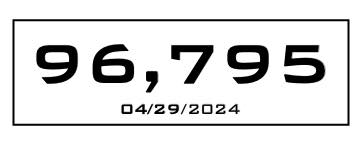
Time
To Renew Your FOA Certifications?
Jobs
- See FOA Jobs
Web Page and FOA on

- The FOA Jobs
- Using your FOA
Training/Certification to Find the Right Job
in Fiber Optics
Where
Are The Jobs In Fiber Optics?
Join The FOA eMail Newsletter
List
Want
to be notified when the FOA Newsletter is updated? Sign
up for the FOA eMail Newsletter.
Trademarks:
The FOA logo and name, CFOT® (Certified Fiber Optic Technician) and
Fiber U® (the FOA online learning site) are
registered trademarks of the FOA.

Want to know more about fiber optics?
Looking for specific information? Here's the largest
technical reference on the web: The
FOA Online Fiber Optic Reference Guide.
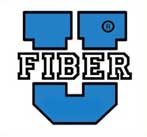
Free online self-study programs
on many fiber optics and cabling topics are
available at Fiber U,
FOA's online web-based training website.
FOA
Reference Books
Available Printed or eBooks
The fiber book is
available in Spanish and French
  
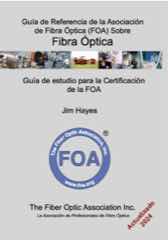
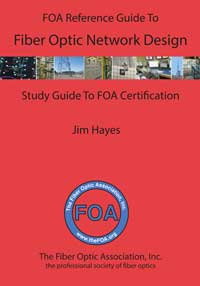 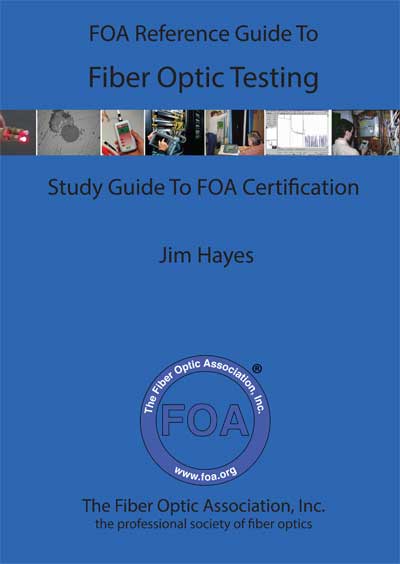 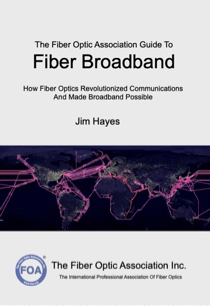
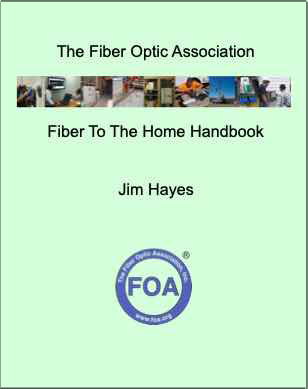 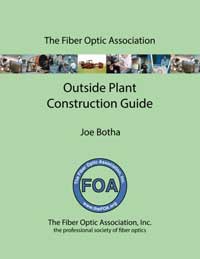 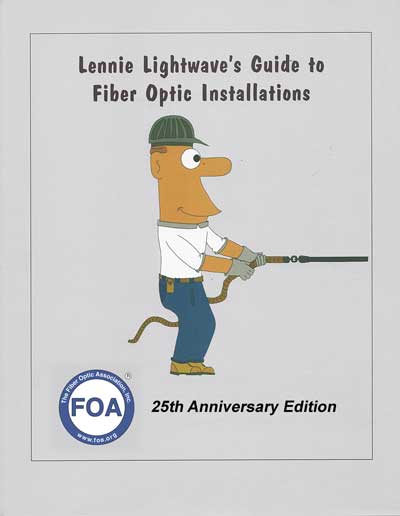
Click on any of
the books to learn more.
- Fiber
Optic Safety Poster to download and
print
FOA Videos on 
FOA
is a member of:
 


The FOA Newsletter is
edited by Jim Hayes - send your stories, leads,
ideas, comments to <jim @ foa.org>

Search the FOA Website With
DuckDuckGo
- The Archives: Past
Issues.
- Use these links to
read past issues or use FOA's
Custom Search to look for specific
topics on our website.
- 1/24,
1/23, 2/23, 3/23, 4/23, 5/23, 6/23, 7/23, 8/23, 9/23, 10/23, 11/23, 12/23
1/22, 2/22, 3/22, 4/22, 5/22, 6/22, 7/22, 8/22, 9/22, 10/22, 11/22, 12/22
1/21, 2/21. 3/21, 4/21, 5/21, 6/21, 7/21, 8/21, 9/21, 10/21,
11-12/21,
1/20,
2/20,
3/20.
4/20,
5/20,
6/20,
7/20,
8/20,
9/20,
10/20,
11/20,
12/20,
1/19,
2/19,
3/19,
4/19, 5/19, 6/19, 7/19, 8/19, 9/19,
10/19,
11/19,
12/19
1/18,
2/18,
3/18, 4/18,
5/18, 6/18, 7/18, 8/18, 9/18, 10/18,
12/18.
1/17, 2/17, 3/17, 4/17, 5/17, 6/17,
7/17,
8/17,
9/17,
10/17, 11/17,
12/17
1/16, 2/16, 3/16,
4/16,
5/16,
6/16,
7-8/16,
9/16,
10/16,
11/16,
12/16
1/15,
2/15,
3/15,
4/15,
5/15,
6/15,
7/15,
8/15,
9/15 ,
10/15,
11/15
, 12/15
1/14,
2/14,
3/14,
4/14,
5/14,
6/14,
7/14,
8/14,
9/14,
10/14,
11/14,
12/14
1/13,
2/13,
3/13,
4/13,
5/13, 6/13,
7/13,
8/13,
9/13,
10/13,
11/13,
12/13
1/12
, 2/12,
3/12,
4/12,
6/12,
7/12,
8/12,
9/12,
10/12,
11/12,
12/12
1/11 ,
2/11,
3/11,
4/11,
6/11,
7/11,
8/11,
9/11, 10/11,
11/11,
12/11,
1/10 ,
2/10,
3/10,
4/10,
05/10,
07/10,
08/10,
09/10,
10/10,
11/10
1/09 ,
2/09,
3/09,
04/09,
05/09,
07/09,
08/09,
09/09,
10/09, 11/09,
12/09
1/08 , 2/08, 3/08, 4/08, 5/08, 6/08, 7/08, 8/08, 09/08, 10/08, 11/08, 12/08
12/07 , 11/07, 10/07, 09/07, 08/07, 07/07, 06/07, 05/07, 04/07, 03/07, 2/07, 1/07
12/06 , 11/06, 10/06, 09/06, 8/06, 7/06, 6/06, 5/06, 4/06, 3/06, 2/06, 1/06,
12/05 ,11/05, 10/05, 09/05, 08/05, 07/05, 6/05, 5/05, 4/05, 2/05, 01/05,
12/04 , 10/04, 9/04, 8/04, 7/04, 6/04, 5/04, 4/04, 3/04, 1/04,
12/03 , 11/03 10/03 9/03, 8/03, 7/03, 6/03, 3/03, 10/02 , 8/02, 5/02
Current Issue of FOA
Newsletter
Time To Renew Your
FOA Certifications?
To
keep your FOA certifications active, you need to
renew them when they expire every 3 years. Now we have a new more
convenient way to renew - an online store at Paypal
- where you can quickly and conveniently use your
PayPal account or your credit card to renew your
certifications.
- Renew
online with a credit card or PayPal
-
Join FOA On
Social Media

FOA
has 3 LinkedIn Groups
FOA
- official page on LinkedIn - covers FOA, technology and jobs in the fiber optic
marketplace
FOA
Fiber Optic Training - open to all, covers
fiber optic technology and training topics
Grupo
de La Asociación de Fibra Óptica FOA (Español)
|
Welcome To 2024
We
always like to start off the New Year with a review of the past year
and some thoughts on the coming year. For the last few years, we used
the word "uncertainty" often in our New Year review, but this year is
looking less uncertain.
2023 At FOA
As you can see from the graph below, FOA added a lot of new certified
techs in 2023 and - look closely - FOA should reach two milestones in another
year - 100,000 certified techs and FOA's 30th anniversary! Those
milestones are indications of how well accepted FOA certifications are
worldwide.
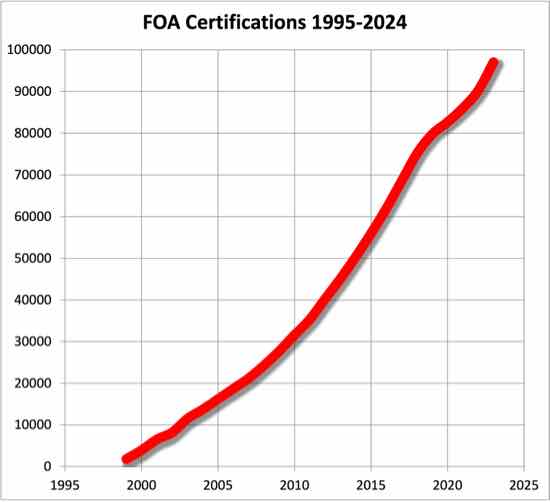
The year 2023 was another year of growth and recovery from the pandemic.
Last year we added a number of new schools and all the schools were busier.
FOA benefited from all the discussions about the need for more trained
and certified workers; FOA was able to point to our successes in
building the workforce needed for projects like Kentucky Wired and you can see the real results of that project below in News.
While others were speculating about the need for more fiber optic techs, FOA was working with the US
Department of Labor Bureau of Labor Statistics (BLS) to define a new job
category - Telecommunications Techs
- that used census data to quantify the fiber optic workforce and create a
realistic estimate of how much it needs to grow. (How many do we need?) With that data, it's
reasonable to assume the current FOA network of training organizations -
currently being expanded by the addition of the states' community and
technical colleges who are joining the FOA network - will be able to
provide the workforce we need for the future.
In 2023 FOA began converting to online credentials for
FOA certifications. That program proved to be so popular that we have
now converted all current FOA certifications to the online credentials
(see below.) Every current FOA certified tech has a personal website
with all their credentials listed and can download a PDF file to print
their own FOA certificate to frame and hang on their wall. Full details on the online credentials are here.
The FOA knowledge base - the textbooks, Online Guide articles and
Fiber U free online self-study courses - also expanded during
the year. FOA translated the FTTH Handbook and Fiber Optic Network
Design textbook into Spanish and also translated the curriculum for
courses at our schools. Soon we will have a new updated Fiber Optic basic textbook
in Spanish too.
2023 In The Fiber Optic Industry
Fiber optics and the Internet are totally integrated
technologies. As Internet traffic continues its incessant growth, fiber
optics grows to make it possible. Some see the telecommunications
business as a battle between fiber to the home landline connections and
wireless, but the truth is there is no battle, it's just that those in
each business often cannot see the "big picture" like AT&T's CEO
John Stankey:
Quote Of The Year: Speaking at the Goldman Sachs Communacopia +
Technology Conference, AT&T’s CEO John Stankey said, “There’s a
fallacy to say there’s fixed networks and wireless networks. There are
only fiber networks with different access technologies on the end of
them. That’s where this is all going.”
Fierce Wireless
A big problem in all technologies is that much of the
news is hype and too many companies believe their own hype. For example.
when the US announced the BEAD program offering billions of dollars (~ $43B
for new networks) of support for connecting unserved and underserved
uses to "broadband" Internet, many companies became excited about what
they saw as a windfall and acted immediately, creating a "bubble" - first a supply
problem then overcapacity and overstock problems. Had they understood
how government programs worked and analyzed the programs accordingly,
they would have realized the programs would take years to develop and
only represented a fractional increase in the actual fiber optic market
(as FOA's analyses in this year's Newsletter have shown.) Instead
2023 saw some manufacturers facing the results of their overreaction,
closing some manufacturing facilities and laying off personnel. It will
take few more years to correct for this bubble.
All the industry's focus in the US seems to have been on broadband for the
home, which the two articles about Kentucky below
shows is shortsighted. Fiber broadband to the home benefits the
individual user, but widespread fiber connectivity benefits everyone, as
the stories about Kentucky's gains in education and business shows.
Fiber broadband to the home cannot exist without a strong fiber
backbone either. The same applies to 5G cellular. The success of
Kentucky Wired shows the importance of backbones and middle mile
projects now being undertaken in other states like California. Perhaps
these
success stories will help overcome the fiber to the home hype and
widen the points of view of the network owners and users and the
industry as a whole in 2024.
The story of Kentucky's success developing their own fiber optic infrastructure and reaping the benefits from it (see News below)
also shows that waiting for a windfall is wasting time. Those who
understood the value of the fiber optic communications infrastructure,
like Kentucky, are now way ahead of those who waited.
The focus on broadband had some benefits for our industry,encouraging
more local community and technical colleges to add telecom and fiber
optics to their degree programs and adult education programs. This is sorely needed because, like every other craft and trade, we face an aging workforce
and have trouble getting young people interested. Many are coming to the FOA as an industry recognized
certification body and take on our proven programs for their workforce
development efforts.
Other factors are influencing schools to encourage students to consider
getting certifications and joining a trade instead of trying
to get a college degree. (What is a "New Collar" worker?)
The FOA's work with the BLS to
create a new "Telecom Tech" job category will help everyone
understand the telecom workforce better and create programs to help us
recruit for the future. It's working already. One of our new state
schools tells us they offered one
class and 24 students signed up, so they had to split it into 3 separate
classes.
2023 brought one more issue to our attention, the need to include
planning for natural disasters in our communications systems designs.
Wildfires, hurricanes, tornadoes, flooding from heavy rainfall, etc. all
caused problems with communications networks, making disaster recovery
much more difficult. In the US, the Federal Emergency Management Agency
(FEMA) contacted FOA for help on recovery operations which led to
discussions on planning for disasters to facilitate recovery. This has
become an important part of project planning.
And What About 2024?
FOA does not see any radical changes coming for this year. In the US,
federal broadband money will begin to trickle out. Around the world
fiber will continue growing as always, connecting continents and island
nations with new undersea cables, fiber penetrating deeper into networks
and more homes being connected. In the US, we see a lot of growth in
electrical cooperatives, just like those coops that FOA has been helping
build their own fiber networks for over a decade now.
Wireless 5G
networks will continue to expand just because that's the current
generation of cellular wireless, even though it doesn't come close to
meeting the hype it was introduced with. 5G is just the next generation
technology and technology always has to keep moving, this time to make
way for 6G which is already in the works.
There seems to be an insatiable appetite for data centers, but the areas
where they are being built is changing. Much of the activity is now in
Latin and South America and the Far East. And more and more submarine
cables are being built to carry the increases in communications traffic,
There is also more concern over the workmanship seen in fiber optic
cable plants. FOA has documented many instances of poor workmanship in
aerial installations and contacts in the industry are documenting
problems with underground installations. Part of the problem is the lack
of standards. There are only a few standards for installation and they
have not been updated for many years. There is now interest in creating
modern standards for installation and work may get started this year.
For the telecom tech and contractor, this could be a good year to
upgrade your gear because it keeps getting better and can enhance your
productivity. Of course, nothing improves productivity more than
investing in training.
And next year, FOA might just reach that magical 100,000 certified fiber optic techs number!
Top articles from The FOA Newsletter in 2023
Fake OTDR Traces Submitted For Testing Documentation January 2023 Tech
Using OTDRs To Test Transoceanic Cables And PONs February 2023
POF - the Other Fiber March 2023
What Do Employers Expect From A Fiber Optic Tech? April 2023
Are Standards Ignoring The OSP? May 2023
FOA Has Proven Results In Fiber Optic Workforce Development June 2023
BEAD Funding For States Announced And Analyzed July 2023
Wisdom From The Street (Analyzing the printing on a fiber optic cable) July 2023
Focus On Disasters August 2023
FOA's Role In Education and Work Done By Fiber Techs September 2023
The Workforce: New US DoL Bureau of Labor Statistics Telecom Tech Category October 2023
How Many Telecom Techs Do We Need and How Big Is The Fiber Optic Market November 2023
Guidelines For Fiber Optic Project Planners December 2023
Guidelines For Fiber Optic Project Planners

This article from the December FOA Newsletter is available as a WEB PAGE IN THE FOA GUIDE to read and share with others.
All FOA
Certification Credentials Are Now Online
Certification credentials online are provided for all FOA certifications.
All FOA Certified Fiber Optic Technicians now have their certification
credentials online. They receive a personal web page that lists all
their certifications, explanations of the certifications and the period
of their validity.
With the
online certifications, you can review your certifications online, post
them on your social media platforms and share them with current or
potential employers or anyone else you choose. Online credentials are
considered the most secure way to provide certifications and are
preferred by most employers today. Printed certificates are available
too, see below.
Note: if your FOA certification has not expired you should have been notified you have an
online credential. If you did not get notification it may be because
FOA did not have a valid email for you. Contact FOA to inquire about your certification credential.
Here is what your online FOA certification credential looks like:
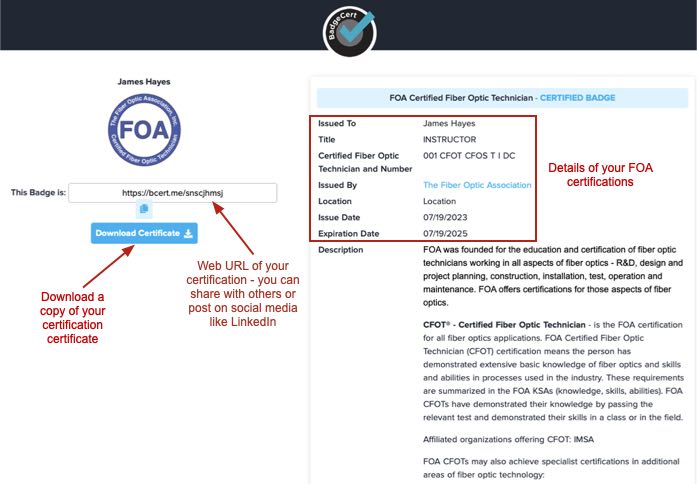
The online FOA certification credential
gives your name, title and company if provided, your FOA certification
number, all the certifications you hold, and the dates your certification
was first issued and the expiration date.
Your online certification works really well on a smartphone too; a great way to share your certification with others.
Did you know you can link your certifications to your profile on
LinkedIn? Directions were sent to you when you got notice of your
certification. If you have already linked your certifications on your
LinkedIn page, you should update it; there was a glitch with some users
that has been fixed. Just erase the current one and reload it.
Print a certificate
If you want a printed certificate as proof of your
certification, there is a button below your certification URL that will
download your FOA certificate as a PDF file. Click on the link and you
will automatically download a
PDF file of the certificate you can print. The printed certificate even has a
QR code to link to your online certification credential.
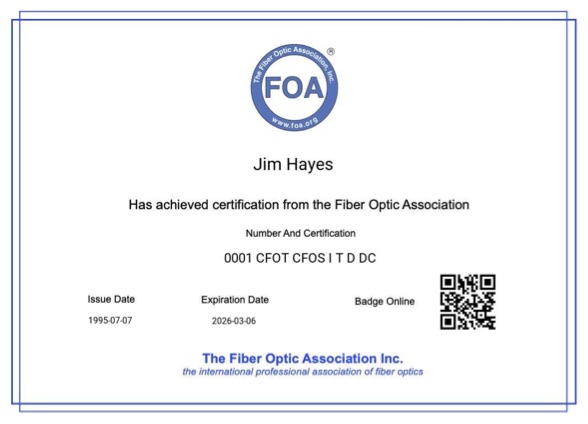
For more information on using your online certification, here is the help page from the provider of the online certifications, https://badgecert.com/user-guides/.
If your FOA Certification has not expired and you did
not get a notice of the electronic credential, it's probably because
FOA does not have the correct email address. Contact FOA
and we can make the correction and issue your online credential. If
your certification has expired in the last 3 years, you are eligible to
renew by paying the renewal fee. Expiration over 3 years requires
recertification.
FOA Curriculum For Schools Adds Fiber Optic Network Design in Spanish
FOA is an inter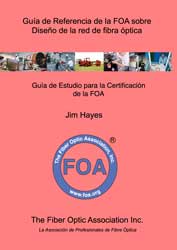 national organization so we have
expanded our website, textbooks and training curriculum to other
languages, with Spanish being the most popular. We have recently
translated the curriculum for CFOS/D Fiber Optic Network Design into
Spanish for our schools in Spain and the Latin and South American
countries. We also have schools teaching in Spanish in the US. national organization so we have
expanded our website, textbooks and training curriculum to other
languages, with Spanish being the most popular. We have recently
translated the curriculum for CFOS/D Fiber Optic Network Design into
Spanish for our schools in Spain and the Latin and South American
countries. We also have schools teaching in Spanish in the US.
The FOA Design textbook is available in Spanish also.
The FOA CFOS/D curriculum in Spanish includes the necessary materials
for an instructor to present the course in Spanish and give thCFOS/D
certification exam in Spanish. The material is available to any
FOA-approved school. For more infirmation on becoming a FOA approved
school, go here.
FOA Guide To Fiber Broadband Is A Hit With Broadband Planners
 How does broadband work? Without fiber optics it would not work; even wireless has a fiber backbone.
This book is not the typical FOA technical textbook - it is written for
anyone who wants to understand fiber broadband or fiber optics or the
Internet. It's also aimed at STEM teachers who want to include
communications technology in their classes. This book will try to
explain not only how fiber broadband works, but how
it was developed. It is intended to be an introduction to
communications technology
appropriate for a communications course at almost any level (junior
high, high school or
college,) for managers involved with broadband projects, or for anyone
who just wonders how all this stuff works. How does broadband work? Without fiber optics it would not work; even wireless has a fiber backbone.
This book is not the typical FOA technical textbook - it is written for
anyone who wants to understand fiber broadband or fiber optics or the
Internet. It's also aimed at STEM teachers who want to include
communications technology in their classes. This book will try to
explain not only how fiber broadband works, but how
it was developed. It is intended to be an introduction to
communications technology
appropriate for a communications course at almost any level (junior
high, high school or
college,) for managers involved with broadband projects, or for anyone
who just wonders how all this stuff works.
The Fiber Optic Association Guide To Fiber Broadband Paperback ($12.95) and Kindle ($9.95) versions available from Amazon or most booksellers. Kindle version is in color!
Cross Reference Guide to Textbooks, Online Guide and Fiber U FOA Videos Guide.
FOA has a web page with resources on fiber broadband and the IIJA/BEAD funding programs.
FOA Newsletter
Sections
News
Technical
Worth
Reading Q&A
Training/FiberU
Resoures
Safety About
|
|
News
Lots more news
in Worth Reading below
|
Kentucky Schools Jump From #49 to #5 In Connectivity In One Year
FOA has written several times about our role in helping Kentucky develop
a workforce to build their fiber optic backbone network "Kentucky
Wired" to connect all 95 counties. The backbone was completed a year
ago, and the workforce built around the 1,200+ CFOTs trained by 9
Kentucky Community and Technical Colleges (KCTCS) was spread all around
the state, ready to build the connectivity needed by government
agencies, schools, and commercial customers.
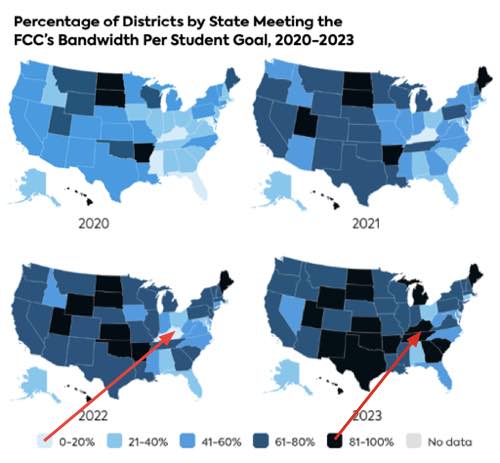 Graphic: Connected Nation Graphic: Connected Nation
And build connectivity they did. In one year, Kentucky schools jumped
from ranking 49th in the US in connectivity to 5th with 97% of all
school districts having access to Internet connectivity at 1Mb/s per
student or above.
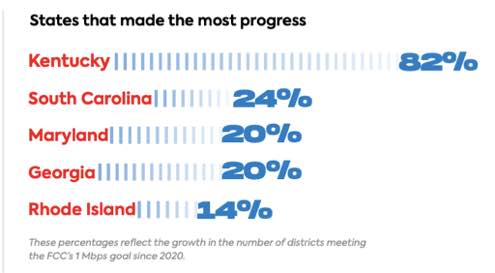 Graphic: Connected Nation Graphic: Connected Nation
That's the power of fiber optics but also the results of wise planning
and understanding the value of investment in infrastructure. When FOA
met with KY Wired officials, contractors and KCTCS schools in 2015 to
create a workforce development program in Kentucky, it was unclear if
such an ambitious infrastructure program could really happen. But KY
Wired survived political changes and cost issues and really shows the
value of investment in fiber optic communications infrastructure pays
off.
But that's not all....
Gov. Beshear: Kentucky Ranks No. 5 Nationally for Business and Infrastructure Investments
Gov. Andy Beshear announced Kentucky ranks fifth in the nation for business and infrastructure investments in Site Selection magazine’s 2023 Global Groundwork Index.
The ranking factors in business investments that generate jobs, as well
as infrastructure investments that help Kentucky families by providing
high-speed internet, cleaner water and safer roads and bridges.
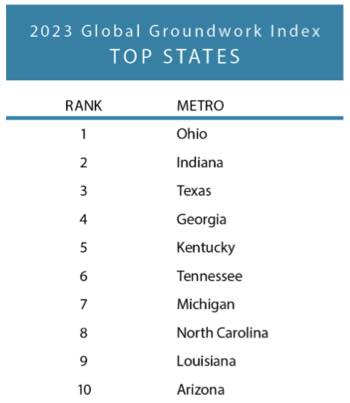 Graphic: Site Selection magazine Graphic: Site Selection magazine
Site Selection magazine also noted the cooperation between states,
especially Kentucky and Ohio. Ohio is a very progressive state also and
is creating programs in their education system that will also make a big
difference in the fiber optic workforce needed for the future. FOA will
report on those projects soon.
References: Connected Nation and Site Selection magazine
WORTH NOTING: All the industry's focus has been on
broadband for the home, which these two articles about Kentucky shows is
shortsighted. Fiber broadband to the home has no possibility without a
strong fiber backbone to connect to. The same applies to 5G cellular.
The success of Kentucky Wired shows the importance of backbones and
middle mile projects being undertaken in other states like California.
Perhaps these two success stories will help overcome the fiber to the
home hype and widen the points of view of the users and the industry.
Are Shark Bites The Cause Of Submarine Cable Failures?
That is one of the favorite myths of fiber
optics; something instantly believable since sharks are one of the most
villified creatures on this planet. That myth is examined by Geoff
Bennett of Infinera in an interesting article in ISE Magazine.
"Like any good urban myth, there is a smattering of truth at play...the
magnetic fields emitted by underwater cables of all types attract those
“evil” sharks, potentially causing them to bite into cables and
creating a world of problems for the service providers who are sending
vital traffic over them."
According to reports by the International Cable Protection Committee
(ICPC), there are between 100 and 200 incidents of damage to cables
around the world each year, but on average only four of those involve
deep water sections of the cable—which would be the most expensive and
time-consuming to repair. All the others occur in shallow water—but how
many of them are caused by sharks?
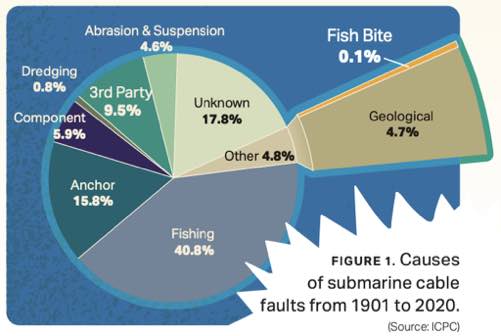 Graphic: ISE Magazine Graphic: ISE Magazine
Here is a breakdown of cable faults for all types of submarine cable
from 1901 to 2020. As you can see, well over two-thirds of cable outages
are man-made in some way. And shark/fish bites have happened but
represent a small part of the problems, most of which are man-made.
Read this interesting article in ISE Magazine
What's Malibu, California Up To?
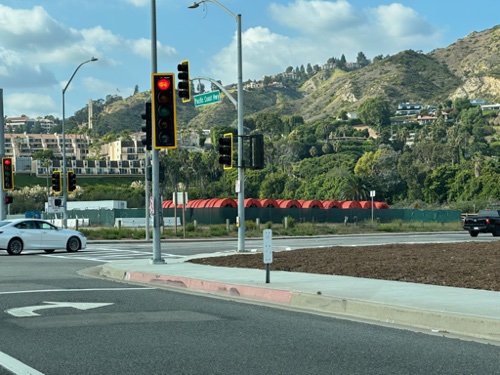
On a recent trip along the Pacific Coast Highway,
also known as “the PCH,” we spotted this field filled with fiber optic
duct near the Malibu town hall. That’s a lot of fiber duct, about 100
reels of it, which indicates that Malibu or the California DOT
(CalTrans) has a big project planned in the area.
Information on the project was easy to track down on the Malibu website.
It’s the “PCH Signal System Improvements Project.” It involves running
fiber along the PCH from Topanga Canyon Road near the Santa Monica city
line to John Tyler Road just North of Pepperdine University. That’s 7.7
miles of fiber to monitor and synchronize traffic signals along the PCH.
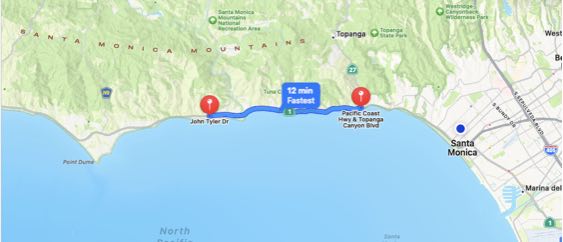
Included in the project are CCTV cameras at each
intersection, ATCS sensors and message signs. Sensors will enable
monitoring traffic flow and speed and adjust signal timing. The Signal
Systems Improvements Project includes new communication links,
changeable message signs, closed-circuit television cameras and traffic
loops, According to the Malibu website, “The use of state-of-the art
technology and synchronization of the traffic signals will make PCH a
"Smart Corridor." "
The PCH has a poor safety record and this project is aimed at enhancing it. Read more about the PCH.
We will be interested to watch the construction and installation on this
project and will report on the progress in the FOA Newsletter in the
future.

The 2024 Optical Fiber Communication Conference
and Exhibition will be held in San Diego on March 24-28, 2024. OFC's
comprehensive educational programming features more than 120 invited
speakers and 9 panels that the latest and future technology and
applications in fiber optics. The panels provide an interactive learning
environment and are open to all conference registrants.
Learn more about OFC.
AT&T files new copper retirement notifications
AT&T Communications has filed a new batch of ‘Copper Retirement
Network Change Notifications’ with the Wireline Competition Bureau (WCB)
of the Federal Communications Commission (FCC), covering locations in
North Carolina, Florida and Arkansas. The North Carolina and Florida
copper retirements coincide with major roadworks, while the Arkansas
copper retirement is a response to the recent theft of 1,000 feet of copper wire, which caused numerous outages.
Affected customers will be migrated to AT&T’s fibre-to-the-premises
(FTTP)/GPON networks. TeleGeography notes that hundreds of Copper
Retirement Network Change Notifications have been filed by AT&T
since 2018. Going forward, the telco seeks to reduce its copper
footprint by 50% by 2025.
Commsupdate.com
Calix Creates Online Training For Service Providers
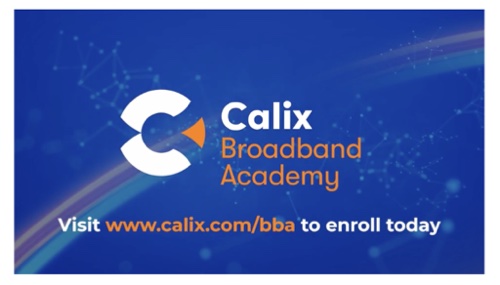
FOA has always been focused on the cable plant and
its design, installation and operation, but the equipment that
communicates over that cable plant is also very important. Calix is one
of the major providers of broadband communications equipment and they
understand the importance of training also. They have created the online
"Calix Broadband Academy"
to educate broadband service providers about the five stages of
building a successful broadband business. The five stages include the
three FOA focuses on, design, installation and operation, but adds two
critical areas faced by a broadband ISP running a business, funding the
operation and marketing to the customers.
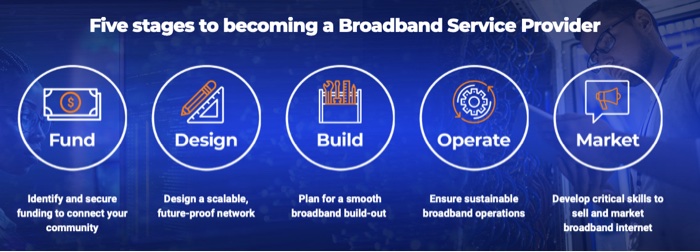
Calix has created a Broadband Academy eBook
that covers the same material in a format that ie easy to share among
others in the agencies working on developing a broadband program.
And they hold the ConneXions conference annually and more virtually for service providers.
At the Calix ConneXions 2023 conference
this fall, FOA provided copies of the FOA book on Fiber Broadband to
hand out to attendees at a "Train The Trainer" session where broadband
leaders learned how they can deliver meaningful and fun broadband
education to their communities.
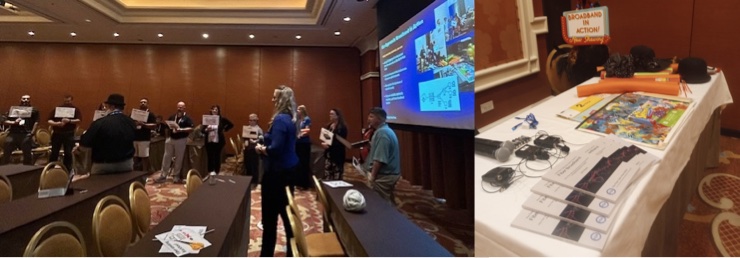
At the Calix ConneXion Confrence, attendees were given copies of the new FOA Guide To Fiber Broadband
At this session Calix announced FOA's Fiber U as their "Install and Repair" curriculum of choice for Calix customers
More on Calix Broadband Academy , the next virtual ConneXions conference Nov 7-9, 2023 and Calix Connections 2024 conference.
FOA Curriculum For Schools Adds Fiber Optic Network Design in Spanish
FOA is an international organization so we have
expanded our website, textbooks and training curriculum to other
languages, with Spanish being the most popular. We have recently
translated the curriculum for CFOS/D Fiber Optic Network Design into
Spanish for our schools in Spain and the Latin and South American
countries. We also have schools teaching in Spanish in the US as you can
read below.
 The FOA Design textbook is available in Spanish also. The FOA Design textbook is available in Spanish also.
The FOA CFOS/D curriculum in Spanish includes the necessary materials
for an instructor to present the course in Spanish and give the cfoS/D
certification exam in Spanish. The material is available to any
FOA-approved school. For more infirmation on becoming a FOA approved
school, go here.
Quote Of The Month:
(several months ago actually, but this is worth repeating)
Speaking at the Goldman Sachs Communacopia +
Technology Conference, AT&T’s CEO John Stankey said, “There’s a
fallacy to say there’s fixed networks and wireless networks. There are
only fiber networks with different access technologies on the end of
them. That’s where this is all going.”
Fierce Wireless
Infrastructure Resources Is Now "Excavation Safety Alliance" - Join Now
Infrastructure Resources has changed its name to Excavation Safety
Alliance (ESA) to better reflect their role in the industry. ESA
believes that a focus on safe excavation education initiatives helps
prevent damage to buried facilities. Focusing on safe excavation
spotlights the importance of safety for the people doing the digging,
and helping keep people safe is the top priority of both damage
prevention and safe excavation efforts.

Join The Excavation Safety Alliance
The
are now over 1,500 individual members of the Excavation Safety
Alliance. The individual memberships are FREE because we want everyone
to have a voice and the ability to get the valuable education.
Individual membership is free; corporate membership is $2000.. For more information, go here.
ESA sponsors the annual Global Excavation Safety Conference which will be held in New Orleans in 2024.

Global Excavation Safety Conference will be held in the city of New
Orleans, Louisiana, from March 19-21, 2024. This is an opportunity for
damage prevention & excavation safety professionals from all over
the world to come together and learn, network, and share their knowledge
and expertise in this vitally important field.
More info on Global ESC 2024
|
Technical
Fiber optic
technology, standards, equipment, installation,
etc.
The FOA
Update Page covers the new technology
and applications we covered in this newsletter
recently. Now you can review all that new tech at
once.

Cross Reference To FOA Technical Reference Materials
The FOA has almost 1,000 pages of technical information on the FOA Guide,
100+ videos and two dozen online courses at Fiber U, all this can make
it difficult to find the right information.
Cross Reference To FOA Tech Materials
To help this, we have created a cross reference guide to the textbooks,
Online Guide and Fiber U courses, all the FOA technical information.
Besides the textbooks, online Guide and Fiber U, each section of the
Guide also includes links to the 100+ FOA videos available.
Cross Reference Guide to Textbooks, Online Guide and Fiber U
FOA Videos
We have also rearranged the 100+ FOA videos in similar categories on the
Contents Page of the Online Guide, making the videos, especially the
lectures, much it much easier to find a video on a particular
topic.
FOA Videos Guide.

Want to know more about fiber optics? Study
for FOA certifications? Free
Self-Study Programs are on Fiber
U®
|
 OptConn
is a value-add re-seller of optical connectivity products, services and
solutions. With over 30 years of experience in the fiber optics
industry we are here to serve your requirements from fiber optic
training with FOA certification to products, materials and supplies. OptConn
is a value-add re-seller of optical connectivity products, services and
solutions. With over 30 years of experience in the fiber optics
industry we are here to serve your requirements from fiber optic
training with FOA certification to products, materials and supplies.
We have partnerships with industry leading
manufacturers to support your installation, splicing and testing needs.
Our goal is to guide, support and recognized our client’s requirements.
Learn more about OptConn
|
NECA/FOA 301 fiber optic installation standard
withdrawn
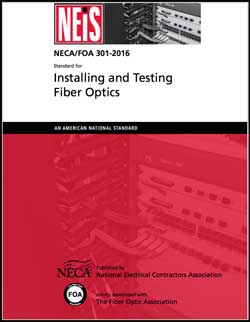 The NECA/FOA 301 fiber optic installation standard has been
withdrawn. It's almost a quarter century old and a decade since the
last update. It has been decided the standard needs to be replaced with a
more modern document covering current technology and written in a
format that allows easier updating. The NECA/FOA 301 fiber optic installation standard has been
withdrawn. It's almost a quarter century old and a decade since the
last update. It has been decided the standard needs to be replaced with a
more modern document covering current technology and written in a
format that allows easier updating.
In the meantime, there is lots of useful information in the standard and you can still download a free copy from FOA.
Download your free copy of ANSI/NECA/FOA-301
here (PDF)
What Exactly Are We Doing Here?
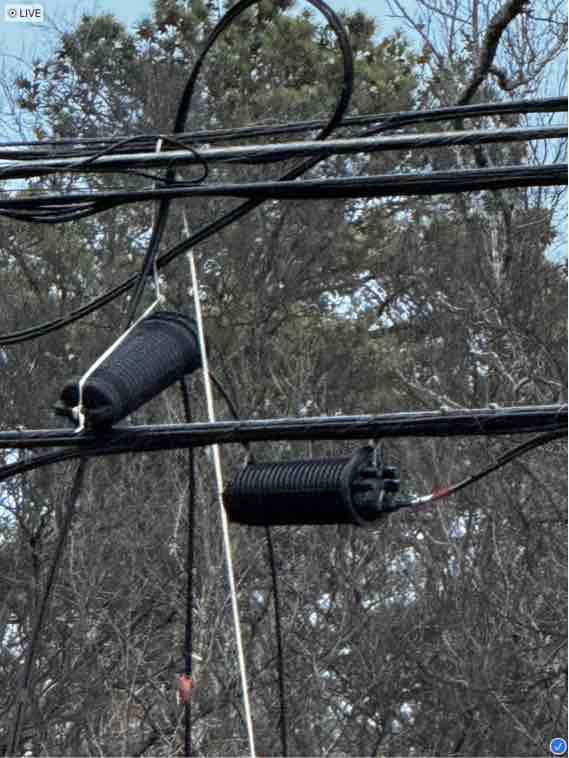
One might think that installers would realize that people can look up and see the quality of their workmanship.
Photo by Eric Pearson in a suburb of Atlanta, Georgia, USA.
Understanding Fiber Optic Splitters
FOA contributor Vladimir Grozdanovic has created
another technical paper on FTTH PON components, this time optical
splitters.
Read Optical Splitters in the FOA Guide.
Learning Important Information From A Found Cable Scrap
While walking down the street near the FOA office, we found this cable
laying in the gutter. What a find! A short length of Corning Rocket
Ribbon 864 fiber cable left over from an installation by a contractor.

We brought the cable back to our office with the intention of opening it
up and creating a video about the construction of this modern high
fiber count cable, but something got our attention first. The cable had a
very
long line of printing on it with lots of interesting and useful
information. So before we started deconstructing it, we decided to
photograph the printed information and interpret it. That turned out to
be an important part of the information we learned from the cable. Then,
as you will see below, we dissected the cable and learned even more.
Red more about what this cable marking tells you and what the cable looks like when you open it up to prepare for splicing.
Problems With Old Cables And New High Fiber Count Cables?
A FOA CFOT reported that they have been doing fiber characterization
testing on cable plants that include both old and new fibers, a common
result from building out from a legacy cable plant. One surprising
result was that some relatively short links are showing CD and PMD
problems even when only short segments of the cable plant are older
fibers. PMD has become an issue as speeds increase but earlier fibers we
not optimized to prevent PMD. This is just another reason to do fiber
characterization before trying to upgrade network speeds. (There is more
information on Fiber Characterization in the FOA Guide and a fiber characterization course on Fiber U.
We're also hearing rumors that the new high fiber
cables are getting fibers broken
during installation with the possible cause(s) being exceeding bend
radius or pulling tension, using improper installation equipment or
maybe even the cable designs. We're investigating this and will report
back in the near future. But please ensure installers follow
manufacturer's recommendations carefully. Check out the information on
cable specs in the article in this issue and the article on Bending Diameter in the FOA Guide.
Managing Fiber Optic Projects - The Gantt Chart
(With An Excel File To Make Your Own)
The most common way to track projects is the Gantt Chart, a
chart of activities that tracks the progress of projects along a
timeline. each activity is represented by a bar and the position and
length of the bar represents the starting date and duration of the
activity. This allows you to see what activities are needed for the
project, when the activities start and end so it can be used to track
the progress of the project visually. Here is what a Gantt Chart for a
fiber project might look like:
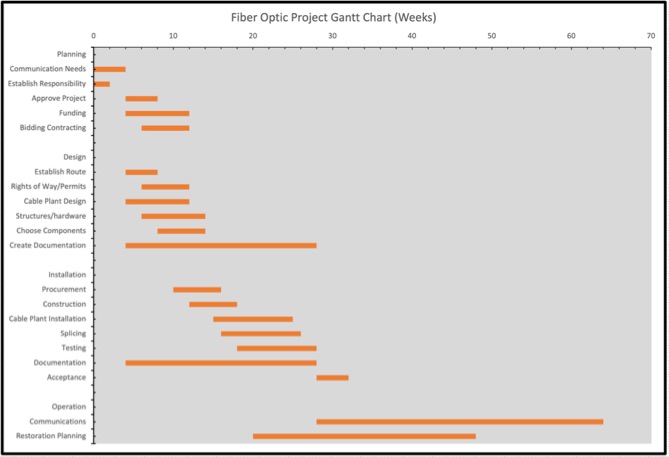
You might remember an article in the FOA Newsletter in April 2022 or the FOA Guide page on Project Management about the timing of a fiber optic project where we showed the progression of steps in a project like this:
The Gantt Chart above is simply this list converted to a Gantt Chart
using a Microsoft Excel spreadsheet. You can download a copy of the FOA Gantt Chart spreadsheet (xlsx file - 16kB)
and use it to create your own Gantt Chart for any project. All you have
to do is to input your own data and change the activity names as
necessary. You can also follow the directions from Microsoft to create your own version.
More Help On Color Codes (Including Copper Cabling And Fiber Optics)
The FOA has created a print-your-own pocket guide to fiber
optic color codes. It has
color codes for fibers and buffer tubes, connectors and premises cables
inside and on the back, QR codes to take you directly to the FOA Guide
and Fiber U. The FOA
Guide page on Fiber Optic Color Codes is one of the most read pages on the FOA
website and the Fiber Optic Color Codes minicourse on Fiber U very popular also.
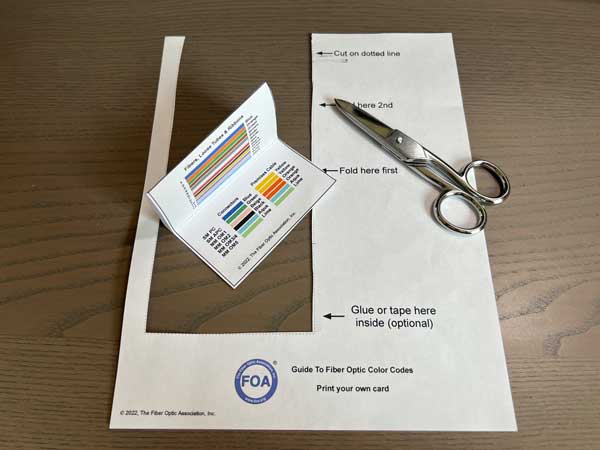 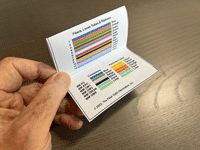 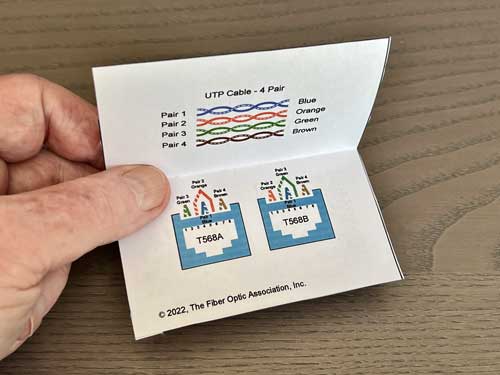
Here's a do-it-yourself FOA Guide To Fiber Optic Color Codes card.
Just download the PDF file, print it on a color printer and fold it up
as shown. Then you have your own pocket guide to color codes. Make a
bunch for your co-workers too.
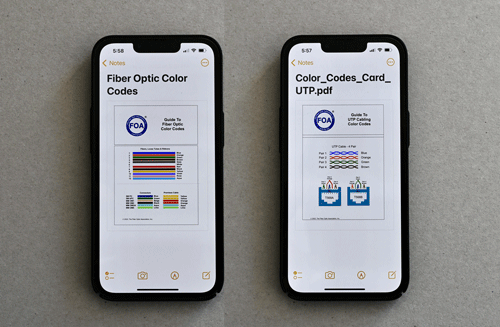 Then we realized that many of your also do structured cabling
work, so it was a natural to add a Color Code Guide for UTP copper
cabling in printable (below) and electronic (above) versions. Then we realized that many of your also do structured cabling
work, so it was a natural to add a Color Code Guide for UTP copper
cabling in printable (below) and electronic (above) versions.
But we did not stop there. We know how many of you use your mobile devices on the job, so we created a version of the Color Code Guide you could download
and use on your smartphone or tablet. It's a PDF file, so you just
download it and save it on your device and it will be with you always.
Here are the links to download your own FOA Guides to Fiber Optic Color Codes
FOA Guide to Fiber Optic Color Codes (print your own version) PDF
FOA Guide to Fiber Optic Color Codes (electronic version for your smartphone, tablet or PC) PDF
And For UTP Cabling
FOA Guide to UTP Cabling Color Codes (print your own version) PDF
FOA Guide to UTP Copper Cabling Color Codes (electronic version) PDF
Warning For Techs Doing OSP Restoration

FOA received an inquiry about whether techs
working on restoring OSP links should be concerned about eye safety if
the link used fiber amplifiers. To answer this question, we had to do some research on fiber amplifiers.
The short answer is YES, you should be concerned. The long answer is
more technical and includes details that every OSP tech needs to know.
See "Fiber Amps And Restoration" in the FOA Newsletter Archives..
Try The FOA's Online
Loss Budget Calculator
FOA
has written many articles about loss budgets,
something everyone involved in fiber optics needs to
know and needs to know how to calculate. We've
created a online Loss Budget Calculator that does
the work for you. Just input your cable plant data
and it calculates the loss budget. It works on any
device, especially smartphones and tablets for field
use and even allows printing the results.
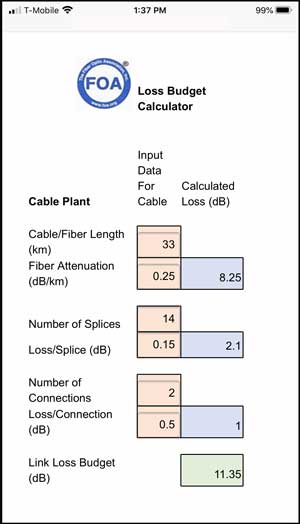
Bookmark
this page (especially on your smartphone): FOA Loss Budget Calculator
Online
|
Worth Reading
Each month we read
hundreds of newsletters and online articles. These
are the ones we think you will find "worth
reading."
FOA has a web page with resources on fiber broadband networks and the IIJA/BEAD funding programs.
Cross Reference Guide to FOA Textbooks, Online Guide and Fiber U
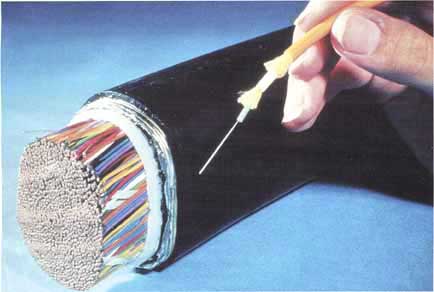 AT&T PR photo from the mid 1970s AT&T PR photo from the mid 1970s
The FOA's History
Top Stories From The Past FOA Newsletters
|
Worth Reading (And
Watching):
December 2023
Wanted: New Collar Workers - NY Times
How Many More Fiber Techs Do We Really Need? - ISE Magazine
Photos: The Growth of Solar-Power Stations - The Atlantic Fascinating photos and every one of them uses lots of fiber optics.
Satellite Operators And Telcos Are Teaming Up - Telegeography
The Winter Issue of Lightwave is online. Focus on coherent optics
Telent builds new network for Greater Manchester, UK public sector agencies - Lightwave
Fiber Across The Suez Canal Using AFL SkyWrap -- AFL
Broadband Monopolies Drive Modern Day Redlining - ILSR "Internet
Ultra" in Los Angeles County is $30/month in affluent neighborhood and
$70/month in neighboring lower income neighborhood. Read more.
November 2023
The Importance of ANSI/SCTE Load Ratings In Underground Enclosure Selection IMSA via Oldcastle Infrastructure. Did you know there are load ratings for underground structures like manholes and handholes?
Space Communications Fibercore Fiber amps in space
Hoopa Valley Tribe and State of California Embark on Historic Collaboration ILSR For the first time, a Tribe in California is building high-speed Internet infrastructure in collaboration with the state
Optical LAN Advances Smart Building Internet of Things’ Scalability, Security and Sustainability APOLAN
50% Underground By 2040? - ESA Magazine
Aerial electrical transmission and distribution lines are a problem in
disasters but how quickly can they be moved underground?
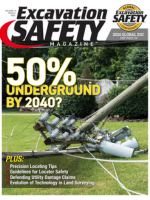 The Winter 2023 issue of ESA magazine The Winter 2023 issue of ESA magazine
October 2023
Fiber vs Wireless - Are You Kidding? ISE Magazine Of course we need both!
Wildfires, Natural Disasters & Network Resilience by Next Century Cities
September 2023
TIA Fiber Optic Technology Consortium "Standards Explorer" Covers Ethernet, more coming.
Developing a Fiber Workforce Really Does Take A Village - ISE magazine looks at the role of manufacturers' training in developing the fiber workforce.
Special For High Level Techs And Engineers:
Standards and Testing Photonic ICs
Point to Multipoint Networks at Infinera
From Past FOA Newsletters
Telegeography Submarine Cable Map 2023 - You can also buy copies - Telegeography
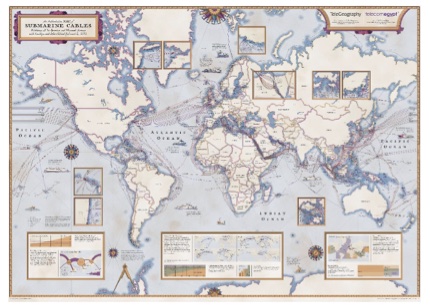
CABL® (cabl.com) serves
the business needs of the Broadband industry (including traditional
cable TV, fiber, telecom and satellite providers) with employment
listings, classified ads, discussion forums, and more. A contractor told us it's where they find lots of opportunities for subcontracting.
Do You Believe In Magic? Sufficiently advanced technology is indistinguishable from magic. ISE Magazine.
The Secret to Future Proofing, ISE Magazine
The 45 Year Old Overnight Sensation - ISE Magazine (Read the complete Nov/Dec issue of ISE Magazine here.
ESRI has created an ebook on GIS location technology for telecom. Use the link to download the book.
The First Transcontinental Telephone Line
began operation on July 29th in 1915 - 3400 miles between New
York and San Francisco - required over 100,000 telephone poles! Wonders
of World Engineering
Conocimiento Esencial: ¿Por qué la fibra óptica? creado por FiberWizards
Recruiting And Training Today's Fiber Optic Workforce - Learn the fundamentals to recruit and train new fiber optics -ISE Magazine.
Google Video On Their Undersea Cables YouTube Slick but interesting video on how undersea cables are designed, built and used.
Construction Without Disruption - ISE Magazine
Fiber Optics Installed By The Lowest Bidder - ISE Magazine
Building Broadband During Component and Worker Shortages
- Broadband Communities - Completing broadband builds requires
competent fiber optic techs, but training them requires understanding
how they learn.
Worth Reading - Magazines, Websites and Newsletters
CABL® (cabl.com) serves
the business needs of the Broadband industry (including traditional
cable TV, fiber, telecom and satellite providers) with employment
listings, classified ads, discussion forums, and more. A contractor told us it's where they find lots of opportunities for subcontracting.
New Fiber Optic
Magazine In Spanish
Todo Fibra Optica is
a new digital magazine in Spanish for fiber optics
in Latin America and South America. Jose Enriquez, editor of Todo
Fibra Optic magazine has many years
experience in the fiber optic industry so he knows
the industry well. FOA will be working with him to
share our extensive technical materials in Spanish.
Read their newsletter here. It is now available online in English and Spanish.
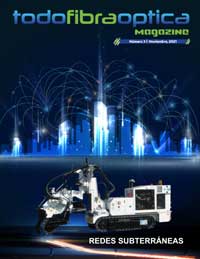
All issues and subscriptions.
Contact:
José Manuel Enriquez Mora, Editor
Todo Fibra Optica LLC
https://todofibraoptica.com/revista-ediciones/
+52 222 302 8224
jose.enriquez@todofibraoptica.com
RTI Telecom Magazine from Brazil, in Portuguese. A revista RTI do mês de abril já está disponível online e recomendo a leitura de alguns artigos:
1995-2020
- FOA's 25th Anniversary!
As
part of celebrating 25 years of serving the fiber
optic industry as its primary source of technical
information and independent certifying body, FOA
thought it appropriate to create a short history of
the organization and how it has developed to
help the fiber optic industry. We also wanted to
recognize the contributions many people have made to
the organization over the years that made FOA what
it is today.
The FOA history is now archived on the FOA
website where you can read it anytime or link to
it. Updated
info - dB, total internal reflection and science
projects,
Worth Reading - News
Summary & History - More Past Links Worth Repeating
1983
Video of AT&T's First Test Of A Submarine
Cable System From the AT&T Tech
Channel archives (worth exploring!)
Richard
Epworth's Optical Fiber History from his work
at STL from 1966 with Charles Kao.
Communications Systems Grounding
Rules: Article 800 provides specific
requirements by
Michael
Johnston, NECA Executive Director of
Standards and Safety in EC Magazine
US Broadband Coverage By Service
Provider from the FCC
How
To Build Rural Broadband, Learning From History
In the August 2021
FOA Newsletter, we published a lengthy article on
rural broadband and compared it to rural
electrification in America in the last century.
Much of the comparison was based on an article
written in 1940 by a USDA economist, Robert Beall,
called "Rural Electrification."
If
you are interested in or involved in rural
broadband, we recommend you read the article "How
To Build Rural Broadband, Learning From History"
in the August 2021 FOA Newsletter and
read the Beall article also.
Recycling Fiber Optic
Cable - Contact:
Steve Maginnis
LD4Recycle/ CommuniCom Recycling
(Visit
website)
sm@LD4Recycle.com
803.371.5436
Sumitomo's Ribbon
Splicing Guide - download from
one of the leaders in splicing.
"Who Lost Lucent?: The
Decline of America's Telecom Equipment Industry"
This is a MUST READ for managers in telecom or any
industry!
This long and
well-researched and annotated article in American
Affairs Journal should be mandatory reading
for every high level manager in a telecom company -
or any other company for that matter. To summarize
the article, today, America has no major telecom
equipment company and fears the major suppliers of
equipment who are all foreign, especially the Huawei
from China. This article explains how America got
into this deplorable state.
OFS also has an excellent
website and blog of tech articles worth browsing.
IEC 60050 - International
Electrotechnical Vocabulary - An
extensive dictionary for fiber optics in English and
French. Highly technical - this is one definition:
"mode - one solution of Maxwell's equations,
representing an electromagnetic field in a certain
space domain and belonging to a family of
independent solutions defined by specified boundary
conditions"
If you are interested in restoration -
aren't we all? - you should also read this
article in dpPro magazine by FOA President Jim
Hayes: Damage Protection Requires
Looking Overhead As Well As Underground
- dpPRO Magazine - about the problems with
aerial cables. His previous article for the
magazine was New Techniques for Fiber
Optic Installation. The Institute for Local
Self-Reliance weekly newsletter has
lots of interesting articles and links.
Universal access to broadband
is a cornerstone to a strong economy,
Achieving universal access will require
community partnerships. by Alfreda
B. Norman, Sr. VP, Federal Reserve Bank of
Dallas
FIBER TO THE FARM: The
co-ops that electrified Depression-era farms are
now building rural internet. Be sure to check out
the high-tech equine installation equipment.
Next Century Cities Newsletter
- News from cities around the US
including Detroit and New York plus small
Infrastructure Get Some
Respect, NY TImes "On Tech"
"The magic of the internet requires a lot of
very boring stuff behind the scenes. "
DIRT
Report On Damage To Utilities Common Ground
Alliance (CGA) annual DIRT report provides a
summary and analysis of the events submitted into
CGA’s Damage Information Reporting Tool (DIRT) for
the year 2018. The complete report is available
for download here. In addition,
there is an interactive dashboard that
allows users to filter the data more by
factors contributing to damages.
Structured Cabling News
- a website and weekly newsletter about cabling.
Fiber Trivia From
Corning.
The
Future Of Work Is Skills - So Stop Worrying
About Degrees - The
reality is the future of work is about skills, not
just degrees. (FOA Newsletter Feb 2020)
The job market is hot. So why
are half of U.S. grads missing out?
VIAVI Books On
Fiber Optic Testing (2 volumes) - They're back!
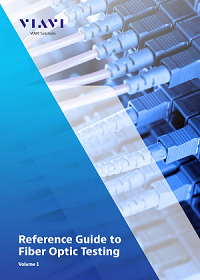 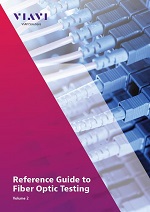
Besides
the FOA reference materials, two JDSU/VIAVI
textbooks, Reference Guide to Fiber Optic Testing,
Volumes 1 and 2, were used as references for
some of the FOA courses and are recommended for
instructors and students. The books are available
from VIAVI as eBooks and the everyone should
download them and recommend them to others.Download
yours now. Volume 1. Volume 2. Viavi Books
Ciena's Submarine Cable
Handbooks (4 to download)
Guidebook To MPO
Testing OptoTest
offers this complete guide to MTP®/MPO testing. In
this guide, you will learn all there is to know
about the different test methods, equipment
options, troubleshooting, and best maintenance
practices to ensure that you have the best testing
experience. Go here to download the book.
50th Anniversary of The
Development of Low Loss Fibers A history
of the development of low loss fiber, a fascinating
story by Jeff Hecht on the OSA (Optical Society of
America) website.
How OFS Makes Fiber
Interesting YouTube video on how fiber is made.
Perhaps a little too much "show biz" but
fascinating. If you have ever seen fiber
manufacture, look at this video. You will be amazed
at how big preforms have become!
The True Cost of Telco Damages
(what backhoe fade or target practice can
cost)
Rural Electric Cooperatives:
Pole Attachment Policies and Issues, June 2019.
Clearfield-FOA Certification
Training Clearfield is now offering
their customers an FOA
CERTIFICATION course. This course
provides a basic understanding of fiber optic
technology, as well as Clearfield product
knowledge and how Clearfield’s integrated product
systems work together in a fiber network.
Substandard Contractors - Fiber
Optic Knowledge Doesn't Always Trickle
Down (EC Mag)
|
Q&A
When readers ask us questions, we genrally refer them to FOA
resources where they can find the answer to their question and many
more. We first send them to the FOA Guide
which is the table of contents for the FOA technical resources. There
they can find pages indexed by topic and a search engine for the FOA
website. It also links them to FOA videos and courses on our free online learning site Fiber U.
The FOA
Fiber FAQs Page (FAQs = frequently asked
questions) gathers up questions readers have
asked us (which first ran in this newsletter)
and adds tech topics of general interest.
|
Good Question!
Tech
Questions/Comments From FOA Newsletter Readers
November 2023
Fiber Loss Budget
Q: For a fibre of total distance of 160km, what should be the standard total loss per kilometre?
A: The typical loss for SM fiber is ~0.35-0.4 dB/km at 1310 nm or
~0.15-0.2 dB/km at 1550. We assume a system like this will be using
1550 nm. You can use the FOA online Loss budget Calculator
https://foa.org/tech/ref/Loss_Budget/Loss_Budget.htm to estimate the
total link loss
Reuse Of Cable Being Removed From Service
Q: Is there ever a feasible reuse for used/older fiber optic cable?
Would some one be in the market for the FOC that is removed from
service? Lets say 20year old aerial cable ADSS?
A: We have been asked that question a lot. It often involves cheap
fiber on eBay or from surplus dealers. With the advances in fiber
technology and manufacturing, 20 or even 10-year old fiber is
essentially obsolete. Lots of service providers are replacing that fiber
with today’s higher performance fibers because networks are going from
the ~2 gigabit speeds then to terabit speeds today. We would never
recommend reusing fiber removed from service. You have no knowledge of
how it was installed originally and environmental conditions can be hard
on some types of cables. Besides, the cost of the cable is only 5-15%
of the project cost. Most of the cost is in the labor of installation so
the savings would be minimal and the risk high.
We have been telling people who have leftover cable from projects to
offer it to FOA schools. They are always in need of OSP cables.
Minimizing Latency
Q: Latency a term that is widely used today. If we manage to
make the light travel without interruption we will achieve that the
speed is perfect, but the equipment (router, OLT, firewall, etc)
generates a processing that takes some time, do you think that LATENCY 0
will be achieved?
A: The work on achieving minimal latency has been gong on for
decades, primarily driven by the computerized stock traders who rely on
microsecond trading. One recent project used an experimental fiber with a
hollow core becasue light travels 50% faster in the air than glass.
Most low latency networks try to use the longest fiber links possible
using submarine cable technology because the electronic switching takes
too much time. But most electronics require digital signal processing in
the transceivers which takes time, switches to the trading computers
takes time and while you can minimize it all, it can never reach “0”.
October 2023
Microtrenching
Q: What is microtrenching?
A: Microtrenching is a technique for installing underground
fiber. It is done by sawing a groove in the road or sidewalk and
dropping a small (~1/2 inch or 13mm) plastic tube (duct) into the
groove and filling it up with material like the surface so it almost
disappears. The cable is “blown” into the duct with high pressure air -
actually the air floats the cable in the duct to reduce friction and the
cable is pushed into the duct.
Here are photos of a microtrenching installation in Toronto. Here is the explanation of microtrenching in the FOA Guide section on OSP Construction (about 3/4 down the page.)
We don’t think any of our schools teach this in the US but Triple Play does in South Africa.
In the US we recommend going to one of the companies that makes the construction equipment, primarily Ditch Witch.
Previous Questions
Degraded Underground Fiber Optic Cable
Q: How can you handle a degraded buried
underground fiber link, which has degraded due to multiple joints
introduced during maintenance?
A: If it has reached a point where the loss or dispersion limits its use, it probably should be replaced.
Maintaining Fusion Splicers
Q: What are the best practices for the preventative maintenance of splicers, cleavers, and thermal strippers.
A: Because of the large number of manufacturers and variety of
models and applications, The FOA generally tells people to follow the
manufacturer’s directions for use and be especially careful about
keeping the splicer unit, cleaver and stripping tools clean, then having
it serviced regularly by the manufacturer or an authorized service
facility.
Rural FTTH
Q: What does A Rural FTTH Connection Cost?
A: That's a very complicated question, because "rural" has a lot
of meanings. Is it a small town where building a FTTH Network is easy or
remote users in Alaska? An interesting set of data was made available
this month from the US Department of Agriculture, announcing $700
million in grants and loans in the 4th round of the ReConnect Program https://lnkd.in/gFe9T4b7.
Splicing Dissimilar FIbers
Q: Recently I came across a new problem while splicing optical fiber
cable. Splicing of 2 Fujikura fibers was done but loss was
observed. Initially, we felt that it is due to splicing but upon
resplicing the loss was still the same i.e. 0.3db at the splice point.
Both the cables were checked again and observed that both cables were
from different manufacturers. My question is that if different
manufacturer's cables are spliced, will it give loss? Note: Both fibers
were Fujikura but had different IOR.
A: The difference in IOR tells the reason. The loss at the joint
between the two fibers when measured by an OTDR depends on the optical
characteristics of the fibers. A difference in the fibers IOR and
backscatter coefficient will cause the loss measurement to be affected.
In one direction it measures too high, in the other direction too low or
even shows a gain. That’s why some measwurements are called gainers. If
you measure it in the opposite direction you should see low loss or a
gain. It’s explained here in the OTDR page on the FOA Guide https://foa.org/tech/ref/testing/OTDR/OTDR.html in the section “OTDR Measurement Uncertainty.”
Testing FTTH Networks
Q: I work on FTTH projects that utilize 1x32 and 1x64 splitters that
do not have any active light on the fibers. Is there a mobile source
that can be used in the field to simulate active light through splitters
and still provide enough power to travel 20km?
A: Any 1310/1490/1550 test source should have adequate power to
test them with a regular power meter. A 64 port splitter has only
18dB+any excess loss- so 20dB or so - and any power meter can measure
that with a ~0dBm to -6dBm source.
More on testing FTTH Networks
OTDR Dead Zone
Q: What is dead zone when using OTDR?
A: The "dead zone" is the length of fiber near the OTDR that is
blanked out by the overload from the test pules. See this page on OTDRs
in the FOA Online Guide: https://foa.org/tech/ref/testing/OTDR/OTDR.html
Using A Visual fault lOcator
Q: What are the best practices for using a VFL to locate fiber faults?
A: See https://foa.org/tech/ref/testing/test/visual.html in the FOA Online Guide
Fiber Splicing Cost
Q: What is the standard of costing for fiber splicing and
terminations? Is it per core / per splice or per each cable end
irrespective of the number of cores?
A: That is a very hard question to answer, other than to say ”it
depends. ” The number of fibers is definitely a factor because each
fiber must be stripped, cleaned, cleaved and spliced then placed in the
splice tray.
It also depends on:
- Single fiber or ribbon splicing?
- Type of splice closure
- Type of cable (loose tube, ribbon, flexible ribbon, high density, armored, ADSS, etc.)
- Installation: aerial or underground
- Location: urban or rural
- Set up time (same for low fiber count cable as high fiber count cable)
Most contracts will be considering the number of
fibers but also these factors, and probably they want to price by the
number of fibers, but the price per splice will vary accordingly. We've
seen quotes in the US for prices varying over a 10X range.
FTTH Network Design Course
Q: I would like some advice on how to develop a responsive curriculum involving FTTH network design.
A: FOA has lots of free resources you can use. Fiber U
offers free online courses in FTTH and Fiber Optic Network Design that
can be used to develop your courses using blended learning - online and
classroom work blended. The courses cover all aspects of these topics
and include lesson quizzes. The Design course includes a dozen case
studies ideal for student assignment, including one on FTTH. You can
also begin with other courses like Basic FIber Optics and Outside Plant
Fiber Optics and Outside Plant Construction. The Fiber U courses draw on
material in the FOA Online Guide where you will find many other pages of useful information.
Teaching a course on FTTH and FTTH Network Design is easy using this
material. The Design labs don’t require equipment; just use the case
studies we provide and develop more of your own.
Markers Required For Underground Fiber Optic Cables?
Q: Are signs required for underground cables like fiber
optic cables? Are they required to have signage so people don’t dig them
up or damage them?
A: In the US the answer is NO. There is no Federal or State law
which requires marking anything other than hazardous liquids and gases.
It is purely a business decision or a moral decision to invest in
signs/markers to protect buried fiber. If a fiber gets cut it can
disrupt 911 service and all kinds of vital communication related to
hospitals, air traffic control, etc.
Fiber Optic Color Codes Reference Chart
Q: Has anyone made a fiber optic pocket reference chart that has cable
color orders, frequencies, or other commonly used info on it?
A: The FOA has a page on its Online Guide that covers color codes
(https://foa.org/tech/ColCodes.htm). It is the most popular page in the
FOA Guide! It works great with a smartphone.

The
word on the "Dig Once" program is getting out - FOA
is getting calls from cities asking us for
information and advice. Here are some links:
The DoT page on the administration’s Executive
Order: http://www.fhwa.dot.gov/policy/otps/exeorder.cfm
And the
one to download and hand out:
A “How To” Guide from The Global Connect Initiative:
https://share.america.gov/wp-content/uploads/2016/04/6.-GCI-Dig-Once.pdf
Is There A Standard
For Fiber Optic Installation?
Note: NECA/FOA 301 has been withdrawn. It's almost a quarter century old
and a decade since the last update. It has been decided the standard
needs to be replaced with a more modern document covering current
technology and written in a format that allows easier updating.
In the meantime, there is lots of useful information in the standard and you can still download a free copy from FOA.
A
question we get often is "Is there a standard for
fiber optic installation." The answer is yes, but
not from the usual standards groups you might
expect. Over 20 years ago, the National Electrical
Contractors Association (NECA) asked FOA to help
create a standard for installation. That standard,
ANSI/NECA/FOA-301 has been updated three times
already and is about ready for another update.
Unlike most of those groups who charge you a fortune
for standards, FOA covers the cost so ANSI/NECA/FOA-301
is available free from FOA.

Download your free copy of ANSI/NECA/FOA-301
here (PDF)
Older
questions are now available here.
|
Training / FiberU
News and resources to help you learn more and stay
updated.
Learn about the fiber optic/ broadband workforce
Find a
listing of all the FOA-Approved schools here.

Free online
self-study programs on many fiber optics and
cabling topics are available at Fiber U, FOA's
online web-based training website.
Free online training at
Fiber U
The FOA has >100
videos on  |
The Types of Work Done By Fiber Techs And How It Affects Training

What is a fiber optic technician? What kinds of work
do they do? Those topics were the center of FOA discussions with the US
Department of Labor Bureau of Labor Statistics that led to the new job
category of "Telecommunications Technician" on the BLS
website. The focus of this job category is primarily the
installation and operation of the fiber optic cable plant, but one
should not forget the cable plant must be designed also as part of a
more extensive communications network.
In our discussion with the BLS analysts, we pointed out the various
stages of a fiber optic communications network project and how techs
with various knowledge and skill sets are needed and involved in every
step. Here is how FOA defines these stages of a project and the skills
of the techs. This is not unique to FOA; it's what has been traditional
at telecom companies forever.
Planning and Design: Once needs for a communications network is
established, project managers will be responsible for all the details of
the project while experienced fiber techs trained and experienced in
fiber optic network design (CFOS/D) will design the cable plant itself. (FOA Guide - Design)
Construction: Aerial cable plants may require installing new poles or
doing make-ready on existing poles and messengers. Underground
construction requires trenching and installation of ducts. In many cases
the actual construction is done by general construction workers, as the
construction work in many cases is not unique to fiber optics. Heavy
machinery is required for much of the construction work and training is
focused on safety as well as operating the machinery. (FOA Guide - Construction)
Fiber Optic Cable Installers: Once the route is prepared, the fiber
optic cable can be installed. Aerial cable installation depends on the
type of cable. Regular OSP cable, figure 8 cable and ADSS cable requires
special hardware and installation techniques so the techs must
understand the process appropriate for each cable. (FOA Guide - Installation)
Splicers: Since the beginning, fiber techs have been called
"splicers"
because that was the original job unique to fiber optics. Construction
and cable installation was not very different from earlier copper
cables, but splicing was very different. Even today, fiber techs are
often called splicers and splicing is a core skill for any fiber tech
whether they are joining cables or terminating them. (FOA Guide - Splicing)
Testers: After the fiber optic cable is installed and spliced,
it must be tested. Testing goes together with splicing since every
splice will be tested, often as soon as it is made so if it needs
redoing, it should be done before the splice closure is sealed. (FOA Guide - Testing)
Network Operators: Once the cable plant is built and the communications
equipment installed, it needs techs who know how to operate the comms
but may only know how to connect new gear or change connections on
current gear. These techs should also know how to troubleshoot systems
in an outage and either do the restoration themselves or call a tech who
can. (FOA Guide - Operation)
These categories merely define the stages of installation of a fiber
optic project. Of course there are subsets of these categories and most
fiber techs are expected to have skills and jobs that cross into
multiple groups, as FOA has defined in the KSAs (knowledge, skills and abilities) for a CFOT.
What an individual worker does differs according to their job. An
independent fiber contractor may cover every job except
operation and a FTTH subscriber installation tech may only understand
installing cables, testing and connecting equipment within the scope of
FTTH systems. A construction company may handle the trenching and even
pole setting as well as parts of the traditional fiber work.
The FOA defined its role early on to focus on educating and
certifying techs in the fiber specific skills: cable installation,
splicing, testing and restoration. FOA would like to see more schools
get into the construction phase, especially for newer techniques like
microtrenching and blowing cable, but these require large outdoor areas
for training and large investments in equipment. Most techs who learn
these processes now do it with OJT - on-the-job-training - and hopefully get OSHA
training for safety.
FOA School News
FOA's roster of approved schools is growing as more organizations
recognize our expertise in workforce development and our comprehensive
support for getting new schools started. FOA has over 25 years
experience and nearly 95,000 certified fiber techs (with ~130,000
certifications). As a non-profit organization founded by the industry
specifically to develop a competent workforce, FOA provides the
consultation, curriculum and contacts to get schools started as a free
service to new schools.
Complete listing of FOA Approved Training Organizations
Need A Fiber Optic Course Onsite? Invite an FOA School To Come To You
FOA often gets inquiries from an organization that
has personnel that needs training in fiber optics. Recent inquiries have
included contractors, a manufacturer of high-reliability products using
fiber optics and a cable manufacturer. In many cases, where there are
several people needing training, FOA can recommend a FOA Approved School
and Certified Instructor who will come to their location to teach a
class. The advantage is of course the savings in travel costs if
the class comes to you, but it also offers the opportunity to customize
the course to fit your needs, even use your equipment or work on your
components, so the training is more relevant to those taking the class.
Contact FOA to discuss the idea of a custom, on-site class to see if it will better meet your needs.
Fiber U
On-The-Job Training (OJT) Program
The
FOA Fiber U OJT program for novices combines online study at
Fiber U with OJT with mentoring by experienced
co-workers and their supervisor to help new employees
develop into FOA-certified technicians in only
one year.
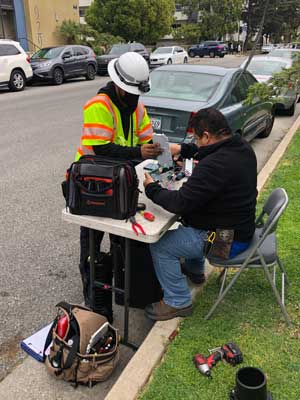
The FOA Fiber U “OJT-To-Cert”
program includes both fiber optics
and premises cabling (copper, fiber & wireless),
so it covers techs working in both outside plant and
premises jobs.
Like other FOA
programs, the OJT-To-Cert program is free. If you
and/or your company is interested in the FOA
OJT-To-Cert program,
contact FOA.
To explain how OJT
works and FOA's OJT-To-Cert program, FOA created a
short video: Lecture 62: On
The Job Training For Fiber Optics Using Fiber
U
FOA
Direct Certification Program For Experienced Fiber Optic Techs
Experience Plus
Online Study At Fiber U = FOA Certification
Experienced fiber optic technicians can become FOA Certified using
their experience in fiber optics and study for the
FOA certification exams online at Fiber U. Thousands of
industry professionals have applied to the FOA
directly for certification without the need for
classroom training, based on their knowledge and
skills developed working the field. Since FOA
certifications are based on KSAs (knowledge, skills
and abilities), current techs can show the
skills and abilities required through their field
experience. FOA provides free online self-study courses at Fiber U for the knowledge
part to prepare you for FOA certification exams
which you can also take online.
If you are an experienced field tech interested in
certification, and FOA is the internationally
recognized certifying body for fiber optics, you can
find out more about the FOA Direct Certification Program
here.
If you are already a CFOT, FOA also offers many
specialist certifications you can obtain based on
your experience as a field tech. See what's
available at Fiber
U.

Fiber U "Basic Fiber
Optics" Online Self-Study Course Now In Spanish
El curso de
autoaprendizaje en línea "Fibra óptica básica" de
Fiber U ahora en español
El sitio de
aprendizaje en línea de FOA, Fiber U, tiene más de
dos docenas de cursos de autoaprendizaje gratuitos
sobre fibra óptica y cableado de instalaciones.
Como era de esperar, el tema más popular es el
curso "Fibra óptica básica", que se utiliza para
iniciarse en la fibra óptica y como curso de
preparación para realizar el examen de
certificación FOA CFOT.
Ahora el curso básico
de fibra óptica está disponible en español,
utilizando el libro de texto FOA en español, la
sección de la Guía en línea en español y la
capacidad de YouTube para traducir subtítulos de
video al español. El curso funciona exactamente
como la versión en inglés con 10 lecciones, cada
una con cuestionarios y una opción para tomar un
examen de Certificado de finalización.
Para presentar el nuevo curso de
español Fiber U, el examen Certificate of
Completion es gratuito, así que dígaselo a sus
contactos.
Curso Básico de Fibra Óptica
de Fibra U en español.
New Fiber U Course: Fiber Characterization
FOA has added a new course at Fiber U on Fiber Characterization. Fiber
characterization is the process for testing long fiber cable plants for
its ability for carrying high speed communications. With so many
networks now operating at 100, 200, 400 or even 800 Gb/s, fiber
characterization is important, especially on older fiber optic cable
plants.The free Fiber U Fiber Characterization course is available in two forms, as a standalone Fiber U fiber Characterization Course with its own Fiber U Certificate of Completion and as a separate Lesson in the Fiber U Fiber Optic Testing course. This course is recommended for those studying for the FOA CFOS/FC Fiber Characterization certification.
Fiber U MiniCourses: Got An Hour Or Less?
Learn Something New About Fiber Optics.
FOA
has introduced a new type of Fiber U
course, the MiniCourse, a free online course you
could take in a short time, perhaps as you ate lunch
at your desk or took a coffee break. The
topics of these courses should explain what they are
about, and these are all very important topics to
fiber optic techs.
New Fiber U MiniCourse - Fiber Optic Jargon
There is a new MiniCourse at Fiber U - Fiber Optic Jargon.
Jargon is the most important thing you need to learn when you learn
about a new technology. This short Fiber U MiniCourse is intended to
introduce you to fiber optic jargon and make learning about fiber much
easier. It's aimed at novices but is a good refresher for even
experienced techs.
Fiber Optics In Communications
Fiber Optic Jargon
How Optical Fiber Works
Fiber Optic Network
Restoration
Fiber
Optic Connector Identification
Fiber U Color Codes
The Mysterious
dB of Fiber Optics
Fiber Optic Cable Bend Radius
Fiber Optic Link Loss And Power
Budgets
Fiber Optic Connector
Inspection And Cleaning
Fiber Optic Media Conversion
Fiber Optic Cable Midspan Access
Reading An OTDR Trace
Reference Cables For Testing
Fiber Optic Attenuators
The courses have two components, video lectures and
readings, that are complementary. As usual there is
a self-test to allow you to check your
comprehension. As with other Fiber U courses if you
desire, you can take a short test for a Fiber U
Certificate of Completion that costs
only $10.
All these free courses and many more
are available at Fiber U.
What Fiber Techs
Don't Know -
What We Learn From
FOA Certification Tests
As
FOA moves more testing over to our digital online
testing system at ClassMarker, we have access to
more data about our testing, including what
questions and topics on the tests are answered
incorrectly most often. Having this data gives us an
opportunity to evaluate the questions and how they
are stated, but more importantly it allow us to help
our instructors teach the subjects and us to change
our curriculum and online courses to emphasize these
particular topics. These are some of the topics that
we have noticed are answered incorrectly more often
in FOA and Fiber U tests.
Most of the questions missed are on testing.
1. OTDRs - particularly what information is in the
OTDR trace.
2. The difference between dB and dBm
3. Loss budgets - both the concepts and doing the
math
4. Insertion loss testing - single-ended or double
ended for testing patchcords or cable plants, how to
set 0dB references
5. Units of measure - fiber is measured in microns,
wavelengths in nanometers, etc.
At FOA, we're working to add Fiber
U MiniCourses on these topics and working with
our schools to emphasize these topics in their
classes.
If you are going to be taking a FOA certification
course or test in the near future, these topics
should be on your final exam study list.
What We Learn From Hands On Labs
We learn about students performance in hands-on labs
from the feedback of our instructors and our own
experiences too. One big problem is the use of hand
tools. Growing up today, you learn how to use
keyboards, mouses and touch screens, but decades
ago, you also learned how to use basic hand tools.
This is big enough of a problem that we're
considering adding some video lessons on basic hand
tools to prepare students for cable prep,
termination and splicing that require the use of
hand tools.

FOA offers free online self-study programs at Fiber U.
Many users are preparing for FOA certification
programs - taking courses at our schools or using
the Direct Certification program. Some of our
schools are requiring Fiber U programs as
prerequisites for their classroom courses so they
can spend more time on hands-on activities.
|
Publications /
Resources

|
Cross Reference To FOA Tech Materials
FOA has so much technical reference material, we created a cross reference guide to the textbooks,
Online Guide and Fiber U courses, all the FOA technical information.
Besides the textbooks, online Guide and Fiber U, each section of the
Guide also includes links to the 100+ FOA videos available.
Cross Reference Guide to Textbooks, Online Guide and Fiber U
FOA Guide To Fiber Optic Workforce Development
To help those new to fiber optic workforce development, FOA has created a web page we call "Fiber Optic Workforce Development."
In this page, we share what we have learned about the fiber optic
workforce, who they are and how they learn their trade. We discuss what
defines a fiber optic tech and how they should be certified.
Read the FOA Guide To Fiber Optic Workforce Development online.
Latest FOA Book: Fiber Broadband (Paperback and Kindle)
 In less than half a century,
fiber optics has revolutionized communications and to a large extent,
society in general. Broadband, what many today call high speed Internet
access, has become a necessity for everyone, not a luxury. The
technology that makes broadband possible is fiber optics, connecting the
continents, cities, and just about everybody. Even fiber to the home
(FTTH) brings broadband to hundreds of millions worldwide. In less than half a century,
fiber optics has revolutionized communications and to a large extent,
society in general. Broadband, what many today call high speed Internet
access, has become a necessity for everyone, not a luxury. The
technology that makes broadband possible is fiber optics, connecting the
continents, cities, and just about everybody. Even fiber to the home
(FTTH) brings broadband to hundreds of millions worldwide.
How did we get from an era when communications was making a telephone
call or sending a telegram to today’s world where every piece of
information – and misinformation – is available at the click of a mouse
or touch on a screen? How did we get from a time when a phone was
connected on copper wires to being able to connect practically anywhere
on a handheld device with more computing power than was available to
scientists and engineers only decades ago?
How does broadband work? Without fiber optics it would not work.
This book is not the typical FOA technical textbook - it is written for
anyone who wants to understand fiber broadband or fiber optics or the
Internet. It's also aimed at STEM teachers who want to include
communications technology in their classes. This book will try to
explain not only how fiber broadband works, but how
it was developed. It is intended to be an introduction to
communications technology
appropriate for a communications course at almost any level (junior
high, high school or
college,) for managers involved with broadband projects, or for anyone
who just wonders how all this stuff works.
The Fiber Optic Association Guide To Fiber Broadband
Paperback ($12.95) and Kindle ($9.95) versions available from Amazon or most booksellers. Kindle version is in color!
More Translations of FOA Textbooks
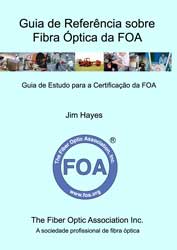 FOA is a very international organization and it works hard to
accommodate the language needs of everyone. We have been translating our
books and website into the languages most requested, and this month, we
add two more textbook translations. We also want to thank Jerry Morla,
FOA CFOS/I instructor and Director who has been doing the recent
translations into Spanish, his native language. FOA is a very international organization and it works hard to
accommodate the language needs of everyone. We have been translating our
books and website into the languages most requested, and this month, we
add two more textbook translations. We also want to thank Jerry Morla,
FOA CFOS/I instructor and Director who has been doing the recent
translations into Spanish, his native language.
Here is a listing of all the FOA textbook Translations
Spanish Editions:
Guía de Referencia de la Asociación de Fibra Óptica (FOA) Sobre Fibra
Óptica: Guía de estudio para la certificación de la FOA Amazon
La Referencia de Cableado para Predios de la FOA: Guía para Certificación de la FOA Amazon
La Asociación de Fibra Óptica Manual de Fibra Hasta el Hogar : Para
Planificadores, Gestores, Diseñadores, Instaladores y Operadores De
FTTH Amazon
Guía de Referencia de la FOA sobre Diseño de la red de fibra óptica: Guía de Estudio para la Certificación de la FOA Amazon
And the FOA Reference Guide To Fiber Optics:
French Edition: Le
Guide de référence de la FOA pour la fibre optique et et
guide d'étude pour la certification FOA: Guide d'étude pour
la certification FOA Amazon
Portuguese Edition: Guia de Referência sobre Fibra Óptica da FOA : Guia de Estudo para a Certificação da FOA Amazon
The subject matter of these books is also translated in the FOA Guide online.
Planning A Fiber Optic Project?
The FOA Guide To Fiber Optic Projects includes this timeline and comments on project planning and implementation.
More New FOA Video
Lectures On YouTube
Did you know YouTube
will close caption videos in many languages?
Here are directions.
FOA Lecture 73, The History of Fiber Optics - A Timeline fiber optics from the beginning.
FOA YouTube Video Describes
On-The-Job Training (OJT)
FOA Lecture 67 Fiber Optics At
Electrical Utilities
More New Videos
Including FTTH Series
Like all our YouTube lectures, they are
all short and easy to understand.
Did
you know YouTube will close caption videos in many
languages?
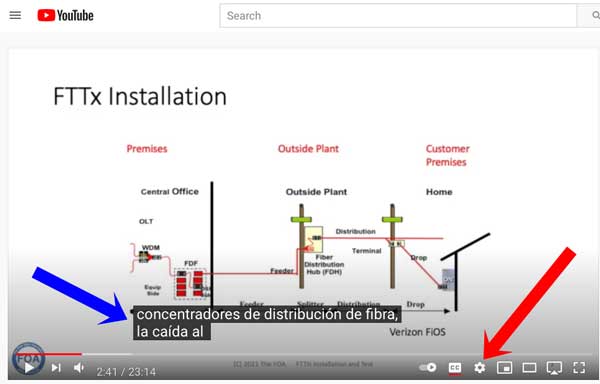
Sign in with Google to get translations for closed
captioning. Click on the settings icon (red arrow.)
Choose "Subtitles". English is the default
language. Click on the arrow after "English
(auto-generated) >". In the new window click on
"Auto-translate" and choose the language you
want.
FOA Loss Budget
Calculator On A Web Page 5/2020
FOA
has written many articles about loss budgets,
something everyone involved in fiber optics needs to
know and needs to know how to calculate. We recently
discovered how to get a spreadsheet ported to a Web
page, so we created this web page that calculates
loss budgets. We have an iOS loss budget app, but
with this web page, you can calculate loss budgets
from any device, smart phone, tablet, laptop, or
desktop computer that has web browsing capability.

Bookmark this page (especially on your
smartphone): FOA Loss Budget Calculator
Online
 We are continually updating the Online Reference
Guide to keep up with changes in the industry and
adding lots of new pages of technical information.
When you go to the FOA
Guide Table of Contents to see the latest
updates - look for
We are continually updating the Online Reference
Guide to keep up with changes in the industry and
adding lots of new pages of technical information.
When you go to the FOA
Guide Table of Contents to see the latest
updates - look for  . .
Recent updates:
FTTH
Updates: Added a section on FTTH Network Design,
updated Architecture and PONs (10G)
Color Codes For Fiber Optics
Includes print your own pocket guide and versions for your smartphone.
Fiber
Optic Projects - the FOA Guide to projects from
concept to operation
Coherent Communications Systems in
the FOA Guide.
Go
to The FOA Online Fiber Optic
Reference Guide.
FOA Reference Books

FOA's FTTH Handbook: We've
gathered all our information on FTTH from the FOA
Guide and past issues of the FOA Newsletter and
edited it into a 112 page "FTTH Handbook." We even
added a section on planning and managing FTTH
Projects.
The Fiber Optic Association
Fiber To The Home Handbook is
available from Amazon in print and Kindle
editions.
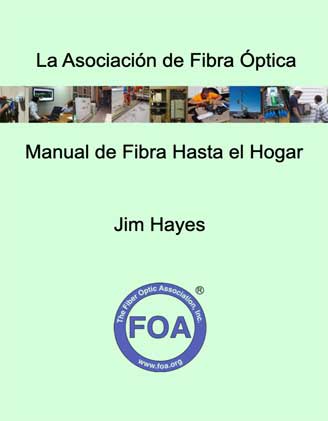
Sitio web y manual de FTTH ahora en español
Sitio web y manual de FTTH ahora en español - FTTH Website And Handbook Now In Spanish
El Manual FOA FTTH se ha convertido en el libro FOA
más vendido y tiene una calificación de 4.7/5 por parte de los
compradores en Amazon.
FOA ha notado mucho interés en FTTH en otras áreas del mundo,
especialmente en América Central y del Sur, por lo que tradujimos el
sitio web de FTTH y el Manual de FTTH al español.
Available in paperback from Amazon or ebook on Amazon Kindle.
Disponible como libro de tapa blanda en Amazon o como libro electrónico en Amazon Kindle.
El sitio web de FOA FTTH ahora en español.
El Manual FOA FTTH se ha convertido en el libro FOA
más vendido y tiene una calificación de 4.7/5 por parte de los
compradores en Amazon.
FOA ha notado mucho interés en FTTH en otras áreas del mundo,
especialmente en América Central y del Sur, por lo que tradujimos el
sitio web de FTTH y el Manual de FTTH al español.
Disponible como libro de tapa blanda en Amazon o como libro electrónico en Amazon Kindle.
El sitio web de FOA FTTH ahora en español.
 
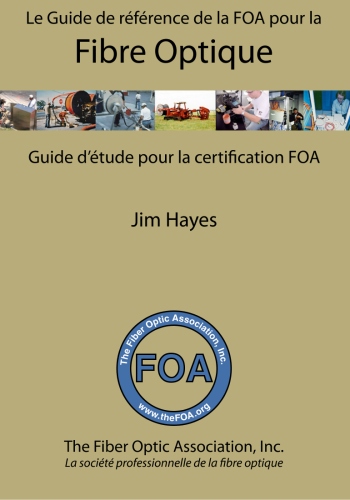      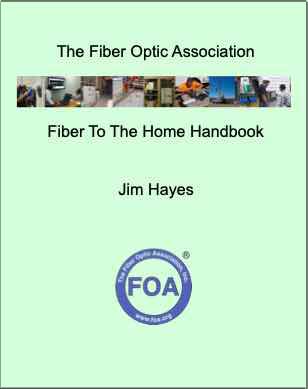
Fiber Optics (4 languages), Premises Cabling, OSP
fiber and construction, Network Design, Testing and
FTTH
The FOA has it's own
reference books for everyone working in fiber
optics - contractors, installers and end users as
well as for use as textbooks in classes at
educational institutions. They are available as
printed books or Kindle at much lower prices than
most textbooks since we self-publish and sell
online, cutting out the middlemen. Click on the
book images for more information. The Reference
Guide To Fiber Optics is also available in
Spanish, French and Portuguese. The Design book is available in English
and Spanish.
Click on any book for more information
about it.
FOA
has reprinted

"Lennie Lightwave's Guide"
on its 25th anniversary in a special print
edition.
Lennie
and Uncle Ted's
Guides are online or as free iBooks on iTunes.
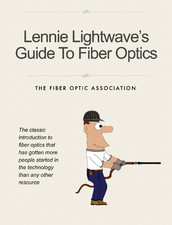
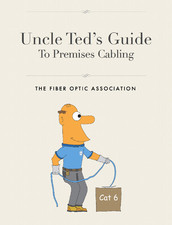
Click on any of
the books to learn more.
- Fiber
Optic Safety Poster to download and
print
Resources For
Teachers In K-12 And Technical Schools
Teachers in all grades can introduce their
students to fiber optic technology with some
simple demonstrations. FOA has created a page for
STEM or STEAM (science, technology, engineering, arts
and math) teachers with materials appropriate to
their classes. Fiber Optic Resources For
Teachers.
|
Safety
|
On Safety
The FOA is concerned about safety!
FOA
considers safety an integral part of all our
programs, curriculum materials and technical
materials. We start all our textbooks and their
online versions with a section on safety in the
first chapter, like this: Before
we get started - Safety First!
There are pages on the FOA Guide on Safety
procedures Including Eye Safety and. Digging
Safely
And a YouTube lecture: FOA Lecture 2: Safety When Working
With Fiber Optics
In our OSP Construction Section, these pages cover
many safety issues including those related to the
construction of the cable plant: Project Preparation And Guidelines,
Underground Cable Construction,
Underground Cable Installation
and Aerial Cable Installation.
There is even a safety poster for the fiber
activities: PDF Safety Rules For Fiber Optics
Other Safety Resources:
There is a toll-free
"call before you dig" number in the USA: Dial 811. See www.call811.com
for more information in the US. Here is their map of resources by states.
In Canada, it's "Click Before You Dig.com" They also have a page of resources by US states and Canadian provinces.
The Common Ground
Alliance has an excellent "Best Practices Guide"
online
- The US Department
of Transportation has a website called "National
Pipeline Mapping System" that allows one
to search for buried pipelines.
Why We Warn You To
Be Careful About Fiber Shards
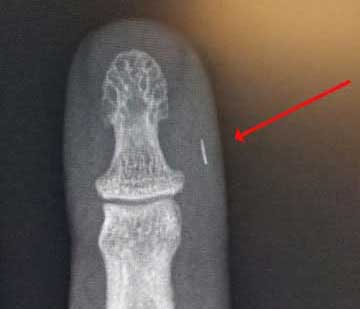
Photo courtesy Brian Brandstetter,
Mississauga Training Consultantcy
FOA
Corporate Program - Products & Services
Search
for products and services offered by hundreds of fiber optic companies worldwide.
List
of corporate information on the FOA website.
FOA Corporate Program is available to companies involved in fiber
optics as manufacturers, contractors, installers, etc. Read
more.
|
FOA/About
About The FOA
- Contact
Us: http://www.foa.org
or email <info@foa.org>

FOA has a company page
and four LinkedIn Groups
FOA
- official company page on LinkedIn
FOA
- covers FOA, technology and jobs in the fiber optic
marketplace
FOA
Fiber Optic Training - open to all, covers
fiber optic technology and training topics
Grupo de La Asociación de
Fibra Óptica FOA (Español)
|
What is The FOA?
The FOA is a, international non-profit
educational association chartered to promote
professionalism in fiber optics through education,
certification and standards.
Founded in 1995 by a dozen prominent fiber optics
trainers and leaders from education, industry and government as a professional society for fiber
optics and a source of independent certification,
the FOA has grown to now being involved in numerous
activities to educate the world about fiber optics
and certify the workers who design, build and
operate the world's fiber optic networks.
Read More
FOA History
FOA Timeline of Fiber Optics
Contact
Us
The Fiber Optic Association Inc.
https://www.foa.org or email
<info@foa.org>
https://www.thefoa.org or email <info@thefoa.org>
Telephone/text: 760-451-3655
The
FOA Home Page

Want to know more about fiber optics? Study
for FOA certifications? Free
Self-Study Programs are on "Fiber U®."
Looking for specific information? Here's the largest
technical reference on the web: The
FOA Online Fiber Optic Reference Guide.

Free online self-study programs
on many fiber optics and cabling topics are
available at Fiber U,
FOA's online web-based training website.
|
-
Contact Us
The Fiber Optic Association Inc.
The FOA Home Page
Fiber Optic Timeline
(C)1999-2023, The Fiber Optic Association, Inc.
|
FOA Logo
Merchandise
New FOA Swag! Shirts,
Caps, Stickers, Cups, etc.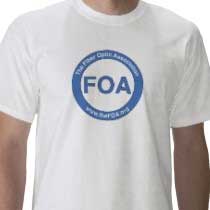
The
FOA has created a store on Zazzle.com offering lots
of new logo merchandise. It has lots of versions of
shirts and other merchandise with "FOA," "Fiber U,"
"Lennie Lightwave" designs and more so you should
find something just for you! See FOA on Zazzle.
-
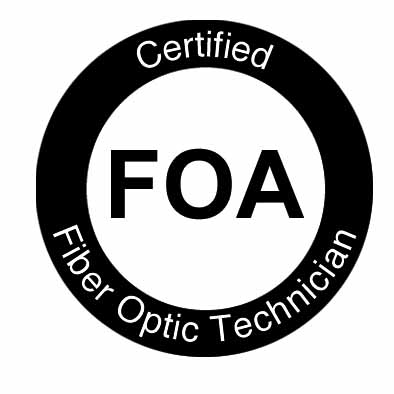
Your
Name, CFOT® - It pays to advertise!
The FOA encourages
CFOTs to use the logo on their business cards,
letterhead, truck or van, etc. and provides logo
files for that purpose. But we are also asked
about how to use the CFOT or CFOS certifications.
Easy, you can refer to yourself as "Your Name,
CFOT" or "Your Name, CFOS/T" for example.
Feel free to use the
logo and designations to promote your achievements
and professionalism!
Contact
FOA at info@thefoa.org to get logos in file format
for your use.
Privacy Policy (for
the EU GDPR): The FOA does not
use cookies or any other web tricks to gather
information on visitors to our website, nor do
we allow commercial advertising. Our website
hosts may gather traffic statistics for the
visitors to our website and our online testing
service, ClassMarker, maintains statistics of
test results. We do not release or misuse any
information on any of our members except we will
confirm FOA certifications and Fiber U
certificates of completion when requested by
appropriate persons such as employers or
personnel services.
Read
the complete FOA Privacy Policy here.
|





















 national organization so we have
expanded our website, textbooks and training curriculum to other
languages, with Spanish being the most popular. We have recently
translated the curriculum for CFOS/D Fiber Optic Network Design into
Spanish for our schools in Spain and the Latin and South American
countries. We also have schools teaching in Spanish in the US.
national organization so we have
expanded our website, textbooks and training curriculum to other
languages, with Spanish being the most popular. We have recently
translated the curriculum for CFOS/D Fiber Optic Network Design into
Spanish for our schools in Spain and the Latin and South American
countries. We also have schools teaching in Spanish in the US. The NECA/FOA 301 fiber optic installation standard has been
withdrawn. It's almost a quarter century old and a decade since the
last update. It has been decided the standard needs to be replaced with a
more modern document covering current technology and written in a
format that allows easier updating.
The NECA/FOA 301 fiber optic installation standard has been
withdrawn. It's almost a quarter century old and a decade since the
last update. It has been decided the standard needs to be replaced with a
more modern document covering current technology and written in a
format that allows easier updating. 










 Graphic:
Graphic:  Graphic:
Graphic:  Graphic:
Graphic: 









 OptConn
is a value-add re-seller of optical connectivity products, services and
solutions. With over 30 years of experience in the fiber optics
industry we are here to serve your requirements from fiber optic
training with FOA certification to products, materials and supplies.
OptConn
is a value-add re-seller of optical connectivity products, services and
solutions. With over 30 years of experience in the fiber optics
industry we are here to serve your requirements from fiber optic
training with FOA certification to products, materials and supplies. 




 Then we realized that many of your also do structured cabling
work, so it was a natural to add a Color Code Guide for UTP copper
cabling in printable (below) and electronic (above) versions.
Then we realized that many of your also do structured cabling
work, so it was a natural to add a Color Code Guide for UTP copper
cabling in printable (below) and electronic (above) versions. 











 .
.






